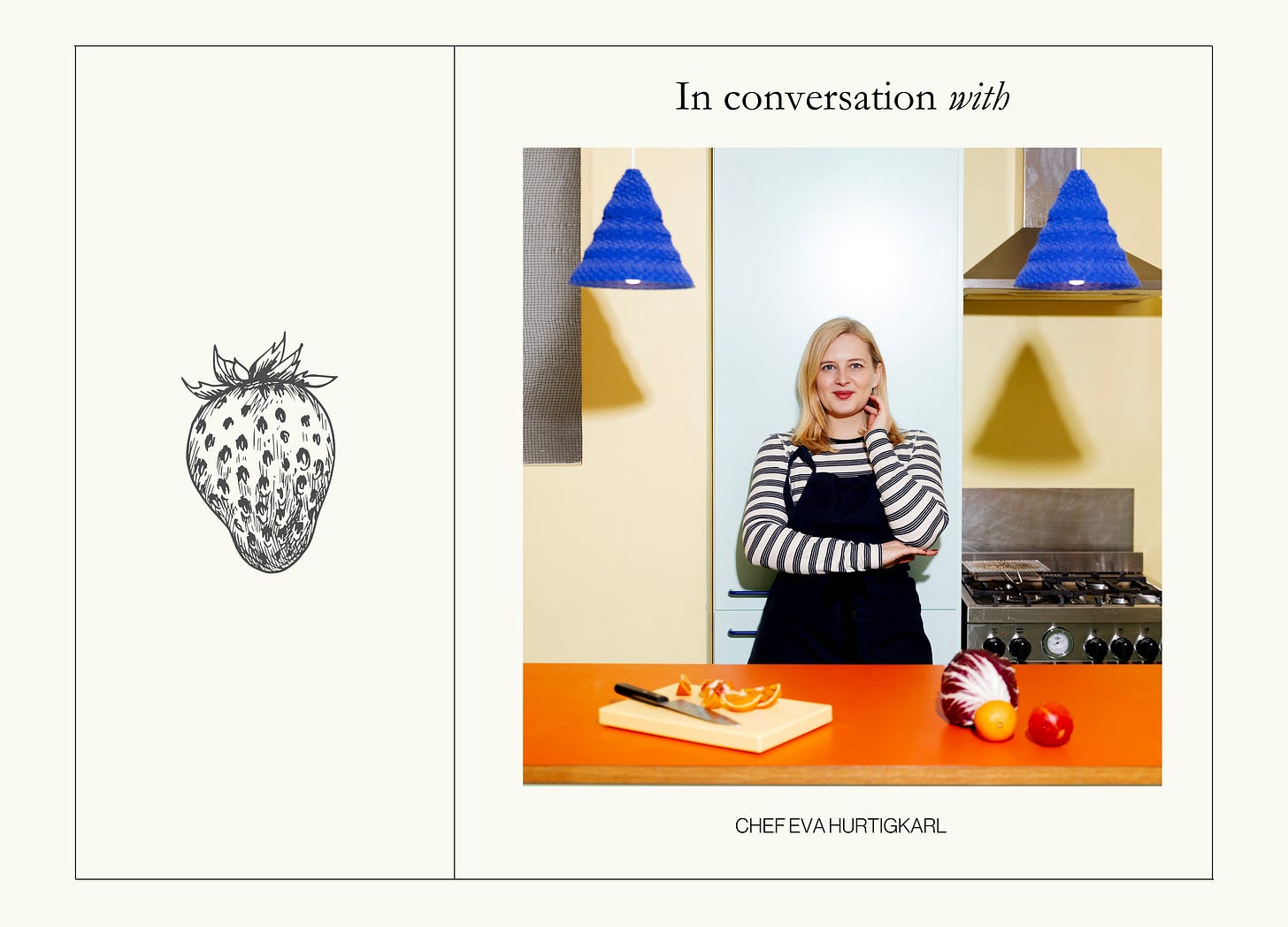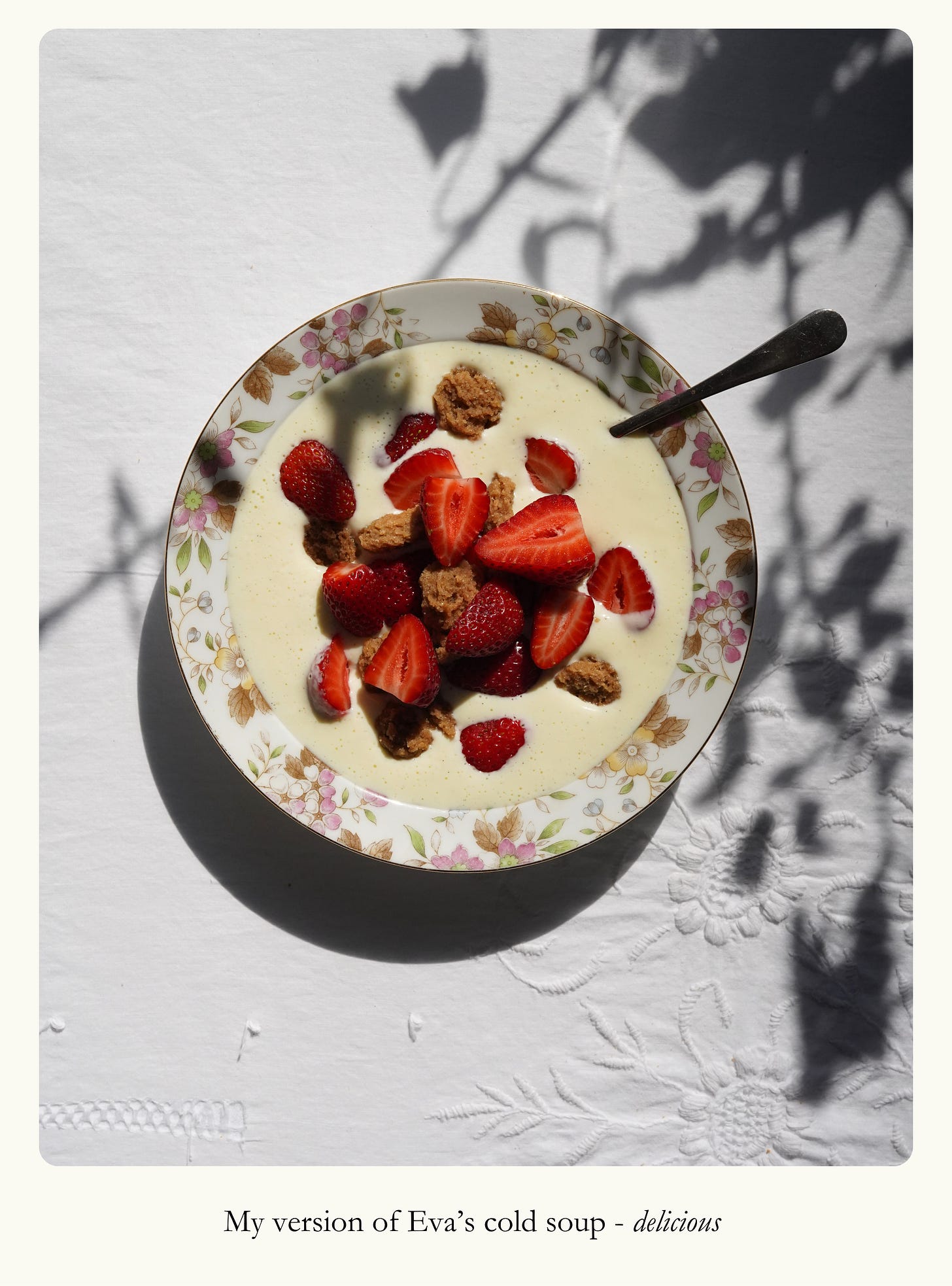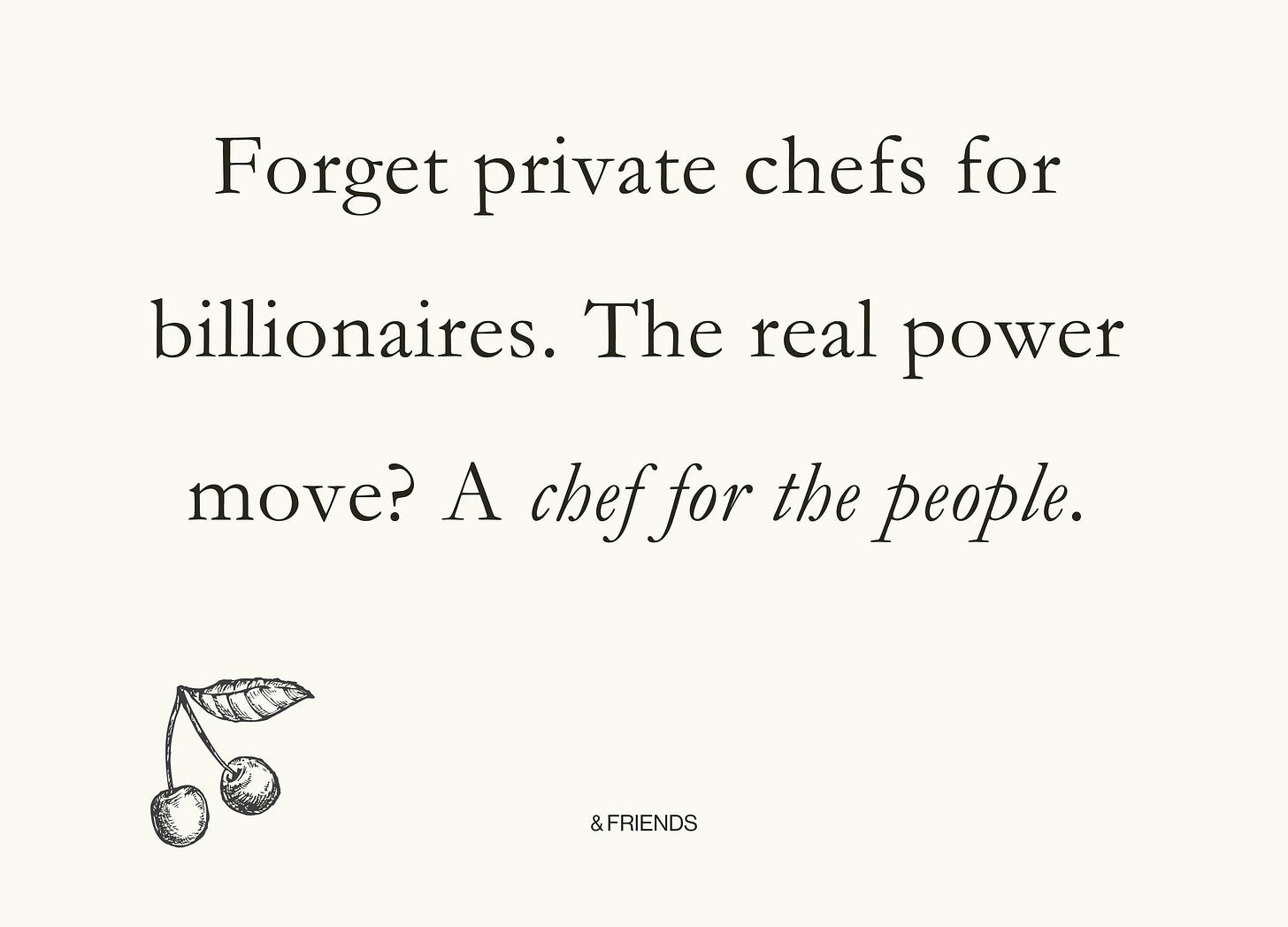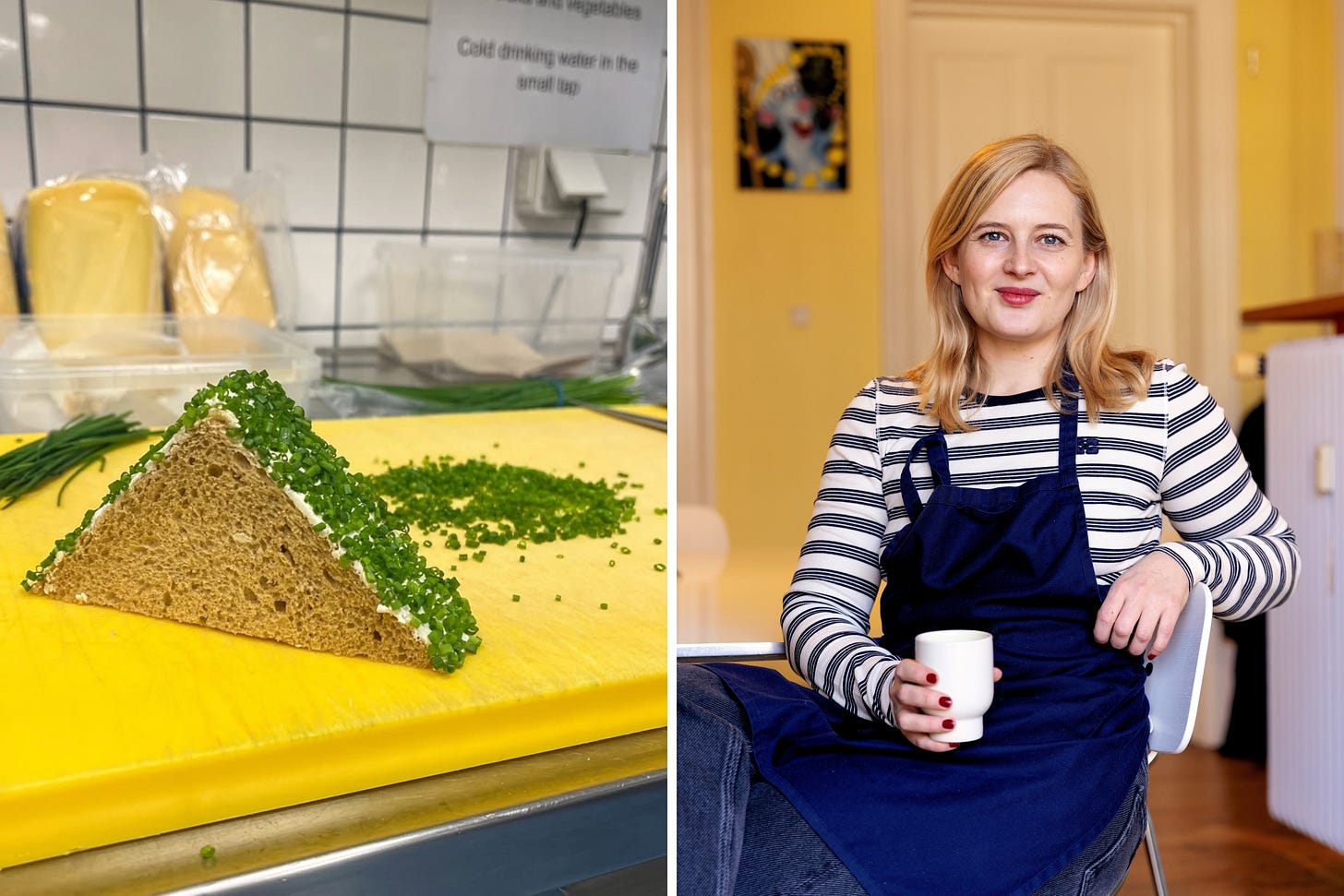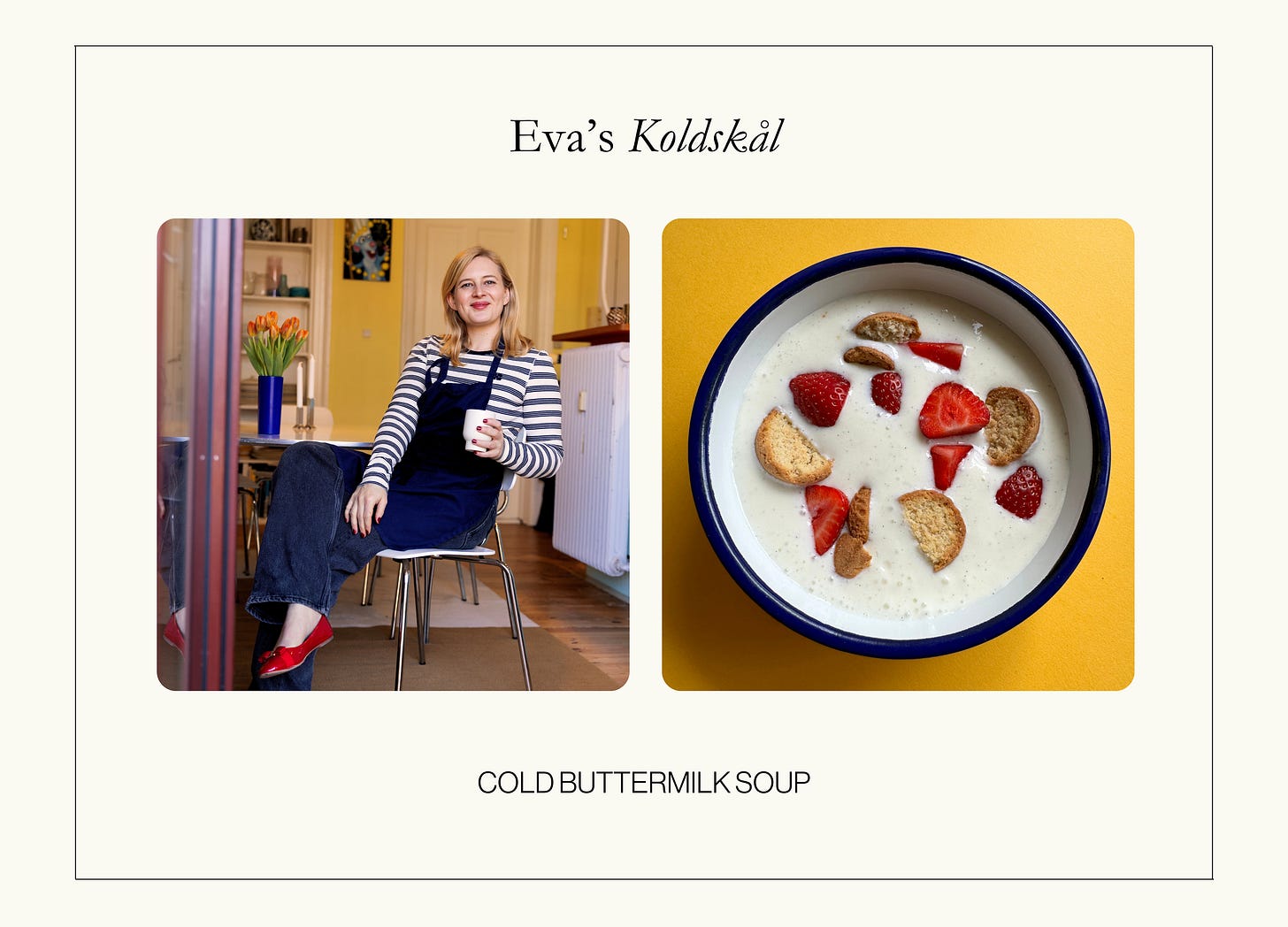Return-to-office mandate? Only if there's a chef and a seasonal restaurant.
Guest recipe and interview with Ganni's in-house chef, Eva Hurtigkarl
Hello all! A rare Friday newsletter, but I couldn’t wait. In today’s & Friends letter: an interview with GANNI’s in-house chef, Eva Hurtigkarl, plus a guest recipe - a traditional Danish cold and sweet buttermilk soup with strawberries and cookies. Trust me, you need this.
Not a subscriber? Join us - you’ll get weekly recipes, travel stories and seasonal menus.
You know what’s more soul-crushing than the commute? It’s not the train delays, the sour smell of the carriage on a rainy day, or the stranger breathing down your neck. It’s that 30-minute office ‘lunch’ - boxed tasteless monotony in a break room with no windows.
As we are all aware, post-pandemic, many companies are enforcing “return to office” policies. Apart from the obvious perks — higher travel costs, longer commutes, hours wasted gossiping by the sad little water cooler — there’s also the daily thrill of the lunch break.
Now, don’t sigh and roll your eyes, after all, you get a solid thirty minutes to line up for the office canteen, where the food is so beige it should come with a trigger warning for nutritional neglect. Alternatively, you can dash out to roam the block searching for something halfway decent and vaguely affordable, before scurrying back to your desk to inhale your prize. Of course, your Slack pings will guarantee that every bite will go down in lumps. At least the school cafeteria gave you jelly...
But then there’s GANNI — the Copenhagen label known for its joyful clothes and now, unexpectedly, for proving that feeding people with care can support a healthier, happier workplace. Instead of rolling out the usual canteen tragedies or having the team fend for themselves, they did something radical: they brought in Chef Eva Hurtigkarl as an in-house culinary lead.
Eva’s brief is simple: make every bite as seasonal, sustainable, and riotously colorful as possible. Picture fish cakes so crisp they practically shatter, a smørrebrød piled high like edible art, creamy tartelettes, and stews brimming with legumes and herbs — a midday buffet bright enough to make the afternoon feel full of possibility.
This is the blueprint every company should adopt (founders/CEOS feel free to steal this idea, or hire me as your creative culinary director). No more limp egg mayo sandwiches scooped off a sad plastic tray. No more grim desk lunches that make you wish you’d never left home. Give people a frittata for goodness sake — fluffy, warm, edges just golden; a salad with real crunch; herbs that taste as though they were picked that morning (because they probably were). And last, but very definitely not least, a chef who understands that feeding people well isn’t just functional — it’s the foundation for a work culture that feels human, creative, and maybe even… joyful?!
Today, Chef Eva shares not only how she traded PR for the kitchen and her favorite ways to cook with a conscience, but also a Substack exclusive from her cookbook - a nostalgic Danish summer recipe.
Sarah: Fill us in on your career path. How did you transition from PR to cooking?
Eva: I did a Bachelor in Communication and English and got a job in advertising at a PR agency as soon as I finished school. I worked with events for alcohol, ice cream and candy brands - you name it, and even worked for a selection of music festivals on the side. That experience was great, but eventually I felt the urge to step away from the computer and travel more. So I quit my job and enrolled in cooking school (fun fact: it’s actually free here in Denmark). For me, food has always felt like a universal language, so the decision just made sense. I did my first internship in Spain, followed by another in Italy, and both experiences deepened my love for cooking. That’s when I knew I’d found my path.
Sarah: How did you end up building a kitchen and shaping the food culture at Ganni?
Eva: It's common in Denmark to have lunch at work. You pay a small amount of your salary every month and then you get lunch (and sometimes breakfast) each working day. Everybody eats together and for many people it's the highlight of the day. Some have chefs in-house, but most places get catering from outside. That was the case for Ganni before I started working there. There's certainly a lot of waste when you don't have a chef to control amounts and reuse leftovers. A friend of mine was working at Ganni and asked if I could cook for them. We set up a meeting with office management and decided to build a kitchen. I had meetings with the architects and they designed the perfect Ganni kitchen. It's now been four years and I think we have really developed a strong food identity.
Sarah: Incredible! I’m curious, how does working at GANNI influence your food creations and philosophy?
Eva: Ganni is such an inspiring environment — even the office space is full of color, and that energy naturally spills into the way I cook. It makes me want to create more vibrant, colorful dishes. When I’m planning the menu, I think about the color of each dish and how everything will look together on the buffet. Luckily, nature tends to get it right — the ingredients that are in season at the same time almost always pair beautifully, both in flavor and appearance. Cooking seasonally really is the secret to food that’s not just delicious, but visually joyful too.
Sarah: I agree with that! And what is one kitchen habit more people should adopt?
Eva: Eat more legumes! They’re good for both our bodies and the planet. Another tip: don’t throw away those vegetable off-cuts or herb stems — toss them into your cooking water to create a flavorful stock. It’s sustainable and adds depth to your dishes. And perhaps most importantly, use your senses. Taste as you go, smell your ingredients, be present in the process. Cooking becomes more intuitive and enjoyable that way — and the end result is almost always more delicious.
Sarah: Speaking of vegetable off cuts, how do you make leftovers exciting?
Eva: I love throwing cooked vegetables and leftover cheese into a frittata. Even old bread can be soaked in milk and added as well. Leftover legumes and vegetables are great in stews — if I don't have much time to cook down the tinned tomato I use tomato purée and water or bean stock. Leftover pasta is great baked in the oven with extra cheese on top. If I have leftover sauce, I will make a comforting pot pie.
Sarah: Any advice for eating more plant-based?
Eva: Again, become friends with the legumes! Batch cook them and use them in salads, dips, stews and soups. Keep them in the fridge or even in the freezer and take them out whenever you need them. Home cooked beans, lentils and chickpeas have more flavor and texture than tinned ones and they're so much cheaper too.
Sarah: What’s a classic Danish dish you love?
Eva: I didn't grow up with a lot of traditional Danish food, but I grew to love it when I studied culinary arts in Copenhagen. I love fish cakes, all kinds of smørrebrød and tarteletter — small puff pastry cups filled with a creamy velouté sauce with asparagus and mushrooms or carrots and peas.
Sarah: Yum! Favorite café?
Eva: Morgenstedet in Christiania - a place I have been going to since I was a child and where I had hummus for the first time. In the summer you can sit in the sun and in the winter their soups will warm you up.
Sarah: Favorite dinner spot?
Eva: Silberbauers, a classic French bistro in Copenhagen that makes the best onion tart and stuffed vegetables.
Sarah: Your most-used ingredient right now?
Eva: Nothing beats new Danish potatoes and I cook them in super salty water with lovage, onion tops, dill stems, asparagus cut-offs and whatever I can find. Best eaten warm with butter, on a piece of rye bread with mayo and fried onions, or in a potato salad with herbs and lots of vinegar.
Keep reading with a 7-day free trial
Subscribe to A Good Table to keep reading this post and get 7 days of free access to the full post archives.



